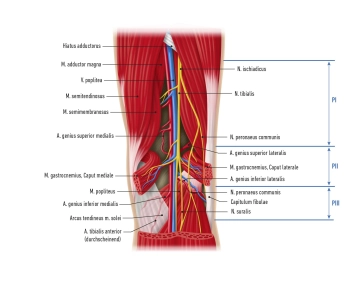The popliteal artery (PA) is 12–18 cm long and has a diameter of about 9 mm, which tapers down to about 5 mm at the runoff vessels. The PA is the direct continuation of the superficial femoral artery and originates in the adductor hiatus, where it is enclosed laterally by the biceps femoris and medially by the semimembranosus muscles (femoral space). In the popliteal fossa, the PA courses between the femoral condyles in the gastrocnemius tunnel, where it is protected medially by the muscle and tendon complex of the pes anserinus. The infrapopliteal PA crosses into the so-called tibial space, crosses the popliteal muscle and divides at its lower border.
Important collateral branches (rete articulare genus) originate in the second segment of the popliteal artery:
- Sural arteries
- Middle genicular artery
- Medial superior / inferior genicular artery
- Lateral superior / inferior genicular artery
Approximately 7 cm inferior to the joint space of the knee at the level of the tendinous arch of the soleus muscle (arcus tendineus musculi solei), the PA divides into the anterior tibial artery and the tibiofibular trunk, the beginning of the crural arteries.
Anatomical variants are present in 5%–8 % of cases. These are mostly variant origins of the tibial arteries and positional variants of the PA in relation to the gastrocnemius and popliteus muscles.
In terms of surgical technique, the PA is usually divided into three segments (PI - PIII), which determine the surgical approach.
Segment | Course/Level | Access |
PI | From the end of the adductor canal to the gastrocnemius tunnel proximal to the knee joint | Distal medial thigh |
PII | Knee joint | Posterior (popliteal fossa) |
PIII | From the infrapopliteal end of the gastrocnemius tunnel to the origin of the anterior tibial artery/tendinous arch of soleus muscle | Proximal medial lower leg |
The PA courses in a vascular-nerve bundle surrounded by fatty connective tissue (popliteal fat depot). While in segments PI and PII the artery courses anteromedial to the popliteal vein (PV), its segment PIII is encircled by the accompanying veins. The tibial nerve and the peroneal nerve lie posterolateral to the PA and PV. In the popliteal fossa, the nerves course rather superficially, which must be considered when exposing the PA from posterior.
The superficial and deep lymph drainage in the popliteal fossa is bundled in three to five perivenous lymph nodes.
Since the location of the PA exposes it to considerable mechanical stress, it is a muscular artery with strong muscle and fiber layers (middle coat, internal elastic lamina). The properties of its walls therefore resemble those of central elastic arteries.

